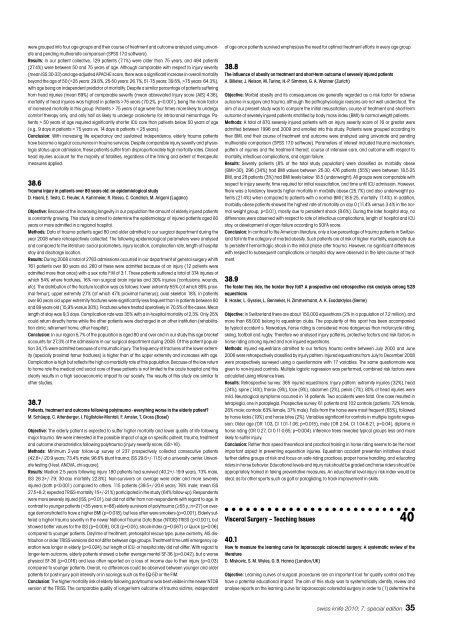Anorectal Manometry in 3D NEW! - Swiss-knife.org
Anorectal Manometry in 3D NEW! - Swiss-knife.org
Anorectal Manometry in 3D NEW! - Swiss-knife.org
Create successful ePaper yourself
Turn your PDF publications into a flip-book with our unique Google optimized e-Paper software.
were grouped <strong>in</strong>to four age groups and their course of treatment and outcome analyzed us<strong>in</strong>g univariate<br />
and pend<strong>in</strong>g multivariate comparison (SPSS 17.0 software).<br />
Results: In our patient collective, 129 patients (7.1%) were older than 75 years, and 494 patients<br />
(27.4%) were between 50 and 75 years of age. Although comparable with respect to <strong>in</strong>jury severity<br />
(mean ISS 30-33) and age-adjusted APACHE score, there was a significant <strong>in</strong>crease <strong>in</strong> overall mortality<br />
beyond the age of 50 (75 years: 64.3%),<br />
with age be<strong>in</strong>g an <strong>in</strong>dependent predictor of mortality. Despite a similar percentage of patients suffer<strong>in</strong>g<br />
from head <strong>in</strong>juries (mean 69%) of comparable severity (mean abbreviated <strong>in</strong>jury score (AIS) 4.36),<br />
mortality of head <strong>in</strong>juries was highest <strong>in</strong> patients >75 years (70.2%, p 75 years of age were four times more likely to undergo<br />
comfort therapy only, and only half as likely to undergo craniotomy for <strong>in</strong>tracranial hemorrhage. Patients<br />
> 50 years of age required significantly shorter ICU care than patients below 50 years of age<br />
(e.g., 9 days <strong>in</strong> patients > 75 years vs. 14 days <strong>in</strong> patients < 25 years).<br />
Conclusion: With <strong>in</strong>creas<strong>in</strong>g life expectancy and susta<strong>in</strong>ed <strong>in</strong>dependence, elderly trauma patients<br />
have become a regular occurrence <strong>in</strong> trauma services. Despite comparable <strong>in</strong>jury severity and physiologic<br />
status upon admission, these patients suffer from disproportionately high mortality rates. Closed<br />
head <strong>in</strong>juries account for the majority of fatalities, regardless of the tim<strong>in</strong>g and extent of therapeutic<br />
measures applied.<br />
38.6<br />
Trauma <strong>in</strong>jury <strong>in</strong> patients over 80 years old: an epidemiological study<br />
D. Haeni, E. Testa, C. Freuler, A. Kuhrmeier, R. Rosso, C. Candrian, M. Arigoni (Lugano)<br />
Objective: Because of the <strong>in</strong>creas<strong>in</strong>g longevity <strong>in</strong> our population the amount of elderly <strong>in</strong>jured patients<br />
is constantly grow<strong>in</strong>g. This study is aimed to determ<strong>in</strong>e the epidemiology of <strong>in</strong>jured patients aged 80<br />
years or more admitted <strong>in</strong> a regional hospital.<br />
Methods: Data of trauma patients aged 80 and older admitted to our surgical department dur<strong>in</strong>g the<br />
year 2008 where retrospectively collected. The follow<strong>in</strong>g epidemiological parameters were analysed<br />
and compared to the literature: social parameters, <strong>in</strong>jury location, complication rate, length of hospital<br />
stay and discharge location.<br />
Results: Dur<strong>in</strong>g 2008 a total of 2783 admissions occurred <strong>in</strong> our department of general surgery whith<br />
761 patients over 80 years old. 260 of these were admitted because of an <strong>in</strong>jury (12 patients were<br />
admitted more than once) with a sex ratio F:M of 3:1. These patients suffered a total of 374 <strong>in</strong>juries of<br />
which 54% where fractures, 16% non surgical bra<strong>in</strong> <strong>in</strong>juries and 30% <strong>in</strong>juries (contusions, wounds,<br />
etc). The distribution of the fracture location was as follows: lower extremity 55% (of which 89% proximal<br />
femur); upper extremity 27% (of which 47% proximal humerus); axial skeleton 18%. In patients<br />
over 90 years old upper extremity fractures were significantly less frequent than <strong>in</strong> patients between 80<br />
and 89 years old (15,9% versus 30%). Fractures where treated operatively <strong>in</strong> 70,5% of the cases. Mean<br />
length of stay was 9,3 days. Complication rate was 35% with a <strong>in</strong>-hospital mortality of 2,3%. Only 25%<br />
could return directly home while the other patients were discharged <strong>in</strong> an other <strong>in</strong>stitution (rehabilitation<br />
cl<strong>in</strong>ic, retirement home, other hospital).<br />
Conclusion: In our region 5,7% of the population is aged 80 and over and <strong>in</strong> our study this age bracket<br />
accounts for 27,3% of the admissions <strong>in</strong> our surgical department dur<strong>in</strong>g 2008. Of this patient population<br />
34,1% were admitted because of a traumatic <strong>in</strong>jury. The frequency of fractures of the lower extremity<br />
(specially proximal femur fractures) is higher than of the upper extremity and <strong>in</strong>creases with age.<br />
Complication is high but reflects the high co-morbidity rate of this population. Because of the low return<br />
to home rate the medical and social care of these patients is not limited to the acute hospital and this<br />
clearly results <strong>in</strong> a high socioeconomic impact to our society. The results of this study are similar to<br />
other studies.<br />
38.7<br />
Patients, treatment and outcome follow<strong>in</strong>g polytrauma - everyth<strong>in</strong>g worse <strong>in</strong> the elderly patient?<br />
M. Schüepp, C. Attenberger, I. Füglistaler-Montali, F. Amsler, T. Gross (Basel)<br />
Objective: The elderly patient is expected to suffer higher mortality and lower quality of life follow<strong>in</strong>g<br />
major trauma. We were <strong>in</strong>terested <strong>in</strong> the possible impact of age on specific patient, trauma, treatment<br />
and outcome characteristics follow<strong>in</strong>g polytrauma (<strong>in</strong>jury severity score, ISS>16).<br />
Methods: M<strong>in</strong>imum 2-year follow-up survey of 237 prospectively collected consecutive patients<br />
(42.8+/-20.9 years; 73.4% male; 96.6% blunt trauma; ISS 29.5+/-11.5) at a university center. Univariate<br />
test<strong>in</strong>g (t-test, ANOVA, chi-square).<br />
Results: Median 2.5 years follow<strong>in</strong>g <strong>in</strong>jury 180 patients had survived (40.2+/-19.9 years, 73% male,<br />
ISS 26.3+/-7.9; 30-day mortality 22.8%). Non-survivors on average were older and more severely<br />
<strong>in</strong>jured (both p
















